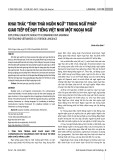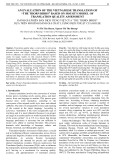
TNU Journal of Science and Technology
229(03): 43 - 50
http://jst.tnu.edu.vn 43 Email: jst@tnu.edu.vn
THE TRANSLATION OF ENGLISH PREPOSITION COLLOCATIONS IN THE
VIETNAMESE VERSION OF JOJO MOYES’S NOVEL “ME BEFORE YOU”
Phan Hoang Bao Han*
Hochiminh City University of Technology
ARTICLE INFO
ABSTRACT
Received:
16/7/2023
The study focused on the translation into Vietnamese of English
Preposition Collocations (EPCs) in the English novel “Me Before You”
and its Vietnamese version by Tre Publishing House. EPCs were
selected as the main data as they are varied in English literary work,
and were suggested as one of the challenges for translators. In terms of
methodology, the study employed qualitative method employing
content analysis to analyze the 108 tokens of EPCs collected in the
source text version. Besides, the study used AntConc. software to
determine whether the suggested combination words are collocations.
The two research questions need to be address in the study relating to
the types of EPCs in the novel “Me Before You” and their Vietnamese
translations, and the strategies applied by the translators in Vietnamese
version. As a result, the study identified Verb-Preposition Collocations
(VPCs) were the most extensively used in the source text and Literal
Translation was the most used strategy in the Vietnamese version.
Furthermore, the seven strategies applied in the Vietnamese version are
Literal Translation, Addition, Reduction, Compression, Modulation,
Transposition, and Adaption.
Revised:
15/8/2023
Published:
15/8/2023
KEYWORDS
English collocations
English preposition collocations
Literary translation
EPCs translation strategy
Novel “Me Before You”
DỊCH THUẬT CỤM GIỚI TỪ TIẾNG ANH TRONG PHIÊN BẢN TIẾNG VIỆT
CỦA TIỂU THUYẾT “TRƯỚC NGÀY EM ĐẾN” CỦA JOJO MOYES
Phan Hoàng Bảo Hân
Trường Đại học Công nghệ Thành phố Hồ Chí Minh
THÔNG TIN BÀI BÁO
TÓM TẮT
Ngày nhận bài:
16/7/2023
Bài nghiên cứu tập trung vào việc dịch thuật các cụm giới từ tiếng Anh
(EPCs) sang tiếng Việt trong tiểu thuyết gốc “Trước Ngày Em Đến” và
phiên bản tiếng Việt của Nhà xuất bản Trẻ. EPCs được chọn làm dữ liệu
do các cụm từ này đa dạng trong văn học Anh, đồng thời cũng trở thành
thách thức cho các dịch giả Việt. Phương pháp nghiên cứu trong bài được
sử dụng là phương pháp định lượng kết hợp với phân tích nội dung để
phân tích 108 cụm giới từ (EPCs) có trong văn bản gốc. Bên cạnh đó, bài
nghiên cứu sử dụng phần mềm hỗ trợ AntConc. để xác định những từ đi
chung với nhau có phải là cụm từ tiếng Anh không. Có hai câu hỏi nghiên
cứu được đặt ra: Một liên quan tới phân loại EPCs tìm thấy trong tiểu
thuyết “Trước Ngày Em Đến” và tương đương dịch thuật trong bản tiếng
Việt, và hai là các phương pháp dịch thuật được dịch giả ứng dụng trong
bản tiếng Việt. Kết quả thống kê được cụm động từ kết hợp giới từ (VPCs)
là cụm giới từ được sử dụng nhiều nhất trong văn bản gốc, và phương pháp
Dịch nguyên văn là phương pháp phổ biến dịch giả dùng trong phiên bản
Việt. Thêm vào đó, có tất cả bảy phương pháp dịch thuật được tìm thấy,
bao gồm: Dịch nguyên văn, Dịch thêm, Dịch bớt, Dịch tóm tắt, Dịch biến
điệu, Dịch chuyển đổi từ loại, và Dịch thoát ý.
Ngày hoàn thiện:
15/8/2023
Ngày đăng:
15/8/2023
TỪ KHÓA
Cụm từ tiếng Anh
Cụm giới từ tiếng Anh
Dịch thuật văn học
Phương pháp dịch thuật cho
EPCs
Tiểu thuyết “Trước Ngày Em
Đến”
DOI: https://doi.org/10.34238/tnu-jst.8321
*Email: phanhoangbaohan@gmail.com

TNU Journal of Science and Technology
229(03): 43 - 50
http://jst.tnu.edu.vn 44 Email: jst@tnu.edu.vn
1. Introduction
Translation is an activity to connect various languages. Therefore, it is indisputable to indicate
that translation remains an imperative role in communication for ages. According to Castillo [1],
language is reflected in people‟s utterances and transmits their messages to others through
various forms, including spoken, written, and sign language. By bridging linguistic divides,
translation can fill gaps in our literature and communication abilities, which are revealed by the
comparative analysis of different languages and traditions of thought. In essence, a translation
should convey not only the surface-level information but also the cultural context and implicit
messages that writers or speakers aim to communicate. Therefore, translation plays a pivotal role
in enhancing international understanding and fostering relationships among people.
Literary translation, an art that has evolved over centuries, is a subject of great interest to
scholars due to its inherent challenges. Translators must apply precise translation principles or
techniques to address these challenges successfully. Landers [2, p. 13] notes that literary
translation poses various difficulties in areas such as fluency, accuracy, register, flexibility, style,
nuance, and transparency. Thus, many problems have arisen in English to Vietnamese translation
because of the differences between the two languages. Precisely, English is known as an
inflectional language in which word form and functions are accordingly changed by word order.
On the other hand, Vietnamese is an isolating language that shortens morphological, markings,
gender, number, or tenses. Collocation is a case in point.
To explain the point, the translation of collocations in literary works can pose significant
challenges due to the lack of recognition of linguistic, stylistic, or cultural features during the
translation process. As Toury [3] notes, literary translation involves two languages and cultural
traditions, each with its norm systems on each level. Therefore, collocations used in literary
works may reflect the cultural background of the source language (SL), which should be
conveyed to readers in the target language (TL). Sa‟eed [4] and Mahmoud [5] agreed that verb
phrases which are combinations of a verb and a preposition is the problematic point amongst
these collocations as they tend to combine with different prepositions to generate various
meanings which depend on contextual conversations. Furthermore, Cao Thi Phuong Dung et al.
[6] conducted a corpus-based study on verb-noun and adjective-noun collocations in English
textbooks for students from elementary to high school. The findings revealed an increase in
collocation frequencies from lower to higher grade levels.
Regarding to translation strategies, Zohre [7] explained that a translator can choose to
translate a source language (SL) text literally or employ various strategies for translation. This is
the justification to conduct a study of comparison common strategies for translation by renowned
theorists such as Viney and Darbelnet (1958), Chesterman (1997). Besides, the study also
adapted the strategies by Monah and Albir (2002) (cited in [8]).
Concerning to the collocations in translation, these following studies are exemplified to
provide a description of how collocation were performed in different languages: Yusra [9]
conducted a thesis that examined the translation of collocations in literary texts from English into
Arabic. The findings revealed the prevalence of the calque translation strategy as the most
commonly employed approach for translating collocations in literary texts, with certain
collocations losing their collocational status in the target text (TT). Additionaly, Putri [10] also
conducted a thesis that focused on the translation of collocations from English to Indonesian in
the renowned fiction "Percy Jackson and the Olympians – the Battle of the Labyrinth." The
findings showed the presence of 437 collocations in the ST, with 356 translated collocations and
81 dynamically translated collocations in the TT. The author concluded that literal translation
was the primary method employed to translate collocations.
As it can be seen from the mentioned theses in terms of collocations in translation, there are
few theses in Vietnam concentrating on translating collocations in literature, while researchers

TNU Journal of Science and Technology
229(03): 43 - 50
http://jst.tnu.edu.vn 45 Email: jst@tnu.edu.vn
investigated the use of collocations instead. When considering foreign theses, the focus on
English Preposition Collocations (EPCs) or grammatical collocations is overshadowed by the
prominence of lexical collocations in the context of professional translation.
The inclusion of English Preposition Collocations (EPCs) in theses, both in foreign countries
and Vietnam, is generally not prevalent within the field of published translation. This lack of
focus on EPCs poses a potential challenge for future translators, as EPCs are frequently
encountered in native English texts. However, a fortunate aspect is that the insights gained from
previous theses investigating collocations can be effectively applied to the translation of EPCs.
The study aims to identify two objectives: English Preposition Collocations (EPCs) used in the
English novel “Me Before You” in terms of types and frequency, and the translation strategies of
EPCs into Vietnamese by the translator. To achieve the two aforementioned objectives, two research
questions are formulated as follows:
(1) What are the English Preposition Collocations (EPCs) used in the novel “Me Before You”
and what are their Vietnamese translations?
(2) What are the translation strategies of EPCs applied by the translator in the Vietnamese
version of the novel “Me Before You”?
2. Theoretical framework and methodology
2.1. English preposition collocations (EPCs)
English preposition collocations which are a combination of a base word (noun/ verb/
adjective) and a preposition can confuse non-native speakers. The present study places
particularly emphasis on examining grammatical collocations that incorporate a prepositional
component. Specifically, the EPCs types in this study extracted from the classification proposed
by Benson et al. [11]. Within the scope of this research, the focus is on classifying preposition
collocations into the following four categories:
(1) Noun-Preposition Collocations (NPCs): This category involves collocations formed by a
noun and a preposition.
E.g., to have interest in…, to have a weekly report on…, to make an impact on….
(2) Verb-Preposition Collocations (VPCs): This category involves collocations formed by a
verb and a preposition.
E.g., to wait for…, to decide on…, to agree with/ upon/ to…, to talk at/ about…
(3) Adjective-Preposition Collocations (APCs): This category involves collocations formed by
an adjective and a preposition.
E.g., be fond of…, be keen on…, be angry with…
(4) Preposition-Noun Collocations (PNCs): This category involves collocations formed by a
preposition and a noun
E.g., by accident, to/ in the hospital, on Earth, on-demand.
2.2. Translation strategies for EPCs
To further enhance the analysis, seven suggested translation strategies are applied based on
the identified Vietnamese equivalents. These strategies aim to provide insights into the
translation choices made for the EPCs and their impact on conveying the intended meaning in the
target language. They mainly adapted from strategies of the aforementioned theorists such as
Chesterman [12], Newmark [13], and Monah and Albir (2002) (cited in [8]) whose strategies
were adapted and edited from Viney and Darbelnet‟s model [14]. To sum up, the translation
strategies for EPCs adapted from these theorists in this study are differentiated into 7 main types:
(1) Literal translation: This is an upgrade of word-by-word translation as the authors
mentioned different structures in both languages. In other words, these translations can be easily
found in a bilingual dictionary.

TNU Journal of Science and Technology
229(03): 43 - 50
http://jst.tnu.edu.vn 46 Email: jst@tnu.edu.vn
(2) Addition (explanation/ paraphrase/ linguistic addition): The strategy is described in the
aforementioned theories simultaneously as the translation equivalent has more words compared
to the original collocation. In this thesis, the strategy is divided into three smaller due to the
translator‟s different purposes: The first type is named “explanation” as detailed information
which is not in the original version was added to explain the plot or make the context became
easily understood. The second type is “paraphrase” which happened when a word or phrase is
difficult to look up its Vietnamese meaning resulting from the lack of an equivalent or the
establish equivalent is fail to express information fully, that is the reason why a translator
paraphrased the undefined meaning collocations into a longer text. The third type is “linguistic
addition” which is derived mainly from the linguistic amplification of Monah and Albir‟s
strategies [14]. The type is the way to add one or more words into the translation version to make
it more acceptable to Vietnamese readers while the original meaning is less changed in the
comparison with two other addition strategies.
(3) Reduction: The strategy in this study is distinguished into two smaller types: Full
reduction and linguistic reduction. The former happens when translators ignore the collocation
during translating process while the latter is driven by one of the linguistic elements in EPCs and
is reduced to keep the flow of text in the TL. Concerning linguistic reduction, the study provides
two smaller types according to the result of the collocation analysis and the Vietnamese
equivalent. The two subtypes of this strategy are preposition reduction and tense reduction.
(4) Compression/ summary: This is a type of reduction adapted from Monah and Albir [14] as
words are reduced or summarized in the TL version when there is no acceptable equivalent found
or the translator tries to avoid the paraphrase strategy to maintain the coherence of the text by
providing the overall meaning of the collocation.
(5) Modulation: The strategy employs different words or expressions to express the same idea
in both SL and TL. Within this study, the Modulation was applied when the translator realized
that the Establish Equivalent no longer fixes the context. Therefore, several techniques were
arisen such as synonymy, antonymy, or a word/ phrase which includes irrelevant meaning can be
used as a replacement.
(6) Transposition: the strategy involves the rearrangement of grammatical structures, word
orders, or word class in order to address disparities between the SL and TL texts. This approach
was motivated by either the uncommon usage of certain linguistic elements in the TL or the
translator‟s intention to ensure the coherence and stylistic alignment of the SL text. Within this
strategy, the translator aimed to modify the structural aspects of the EPCs while preserving the
overall meaning and conveying the intended message effectively in the TL.
(7) Adaption: The translator tried to localize the EPCs or rewrites them to accommodate
differences in culture and Vietnamese context.
3. Research methodology
3.1. Research design
The current study applied the qualitative method in using and content analysis in terms of
comparative and contrast approaches to obtain and evaluate data.
3.2. Sample and sampling procedures
The data utilized in this study consist exclusively of English preposition collocations (EPCs)
extracted from the novel “Me Before You” by Jojo Moyes and its corresponding Vietnamese
translation. The selection of this material is motivated by the fact that it is authored by a well-
known English writer renowned for her contributions to the romantic genre. Consequently, the
EPCs quoted within the novel can be considered commonly employed by native English
speakers. With a total word count of 137,398 distributed across 409 pages, the novel
encompasses a prologue, 27 main chapters, and an epilogue.

TNU Journal of Science and Technology
229(03): 43 - 50
http://jst.tnu.edu.vn 47 Email: jst@tnu.edu.vn
The sample for this study comprised a total of 108 English preposition collocations (EPCs)
extracted from the prologue and the first five chapters of the novel. The key justification to minimize
the sample selection was attributed to the scope of the study following a M.A. thesis. Therefore, all
selective chapterswere manageable within 57 pages and were chosen for convenience sampling.
3.3. Data collection procedures
In this study, AntConc was employed as the primary tool for analyzing collocational
combinations consisting of a base word and a preposition. AntConc was chosen for its versatility,
cost-effectiveness, and reputation as a reliable software for corpus analysis. Developed by
Laurence Anthony, a well-known professor at Waseda University in Japan, AntConc has been
widely utilized in previous research studies examining various linguistic phenomena.
To analyze the data, the researcher imported text files as the original novel‟s pdf version by
choosing File and tab Open File (s) as “Quick Corpus” on AntConc‟s toolbar. After importing the
main corpus, the next step of the procedure would be carried out: EPCs sketching. The
collocations in AntConc can be sorted by the score of frequency, and likelihood.
3.4. Data analysis procedures
In order to answer the two research questions, the analysis procedure of this study is essential,
and it involves these steps: Firstly, 108 EPCs were categorized into four types based on the structure
of the word sequences, namely NPCs, VPCs, PNCs, and APCs. This step aimed to identify word
sequences and sentences in the original novel, and the most frequent EPCs were suggested.
Secondly, the Vietnamese equivalent for these EPCs was selected from the Vietnamese
version. Each translation text was arranged especially under the original sentence to show
differences or similarities of both EPCs and their equivalent in both texts.
Finally, according to the equivalent, the 7 strategies previously suggested in section 2 were
applied in order to explore how EPCs were translated in the Vietnamese version, in other words, the
final step primarily focuses to address the second research question. Precisely, these strategies were
named: Literal Translation, Addition (Explanation, Paraphrase, Linguistic Addition), Reduction
(Full Reduction, Linguistic Reduction), Compression, Modulation, Transposition, and Adaption
according to renowned theories by Chesterman [13], Newmark [5], Monah and Albir [14].
4. Results
4.1. English Preposition Collocations (EPCs) in the novel “Me Before You”.
The first sub-section attempted to discover types and frequency of EPCs existed in the SL
texts of the novel “Me Before You”. The primary dataset consisted 108 EPCs that were extracted
from the original texts [15]. In this particular sub-section, a qualitative approach was employed to
gather and categorize the EPCs into their respective types, namely VPCs (Verb-Preposition
Collocations), NPCs (Noun-Preposition Collocations), APCs (Adjective-Preposition
Collocations), and PNCs (Preposition-Noun Collocations).
For the summarized data, table 1 presented the statistical numbers pertaining to EPCs and
types of EPCs encompassing VPCs, NPCs, APCs, and PNCs. Overall, the statictis showed that
VPCs took the largest percentage in comparison with other types of EPCs.
Table 1. EPCs and types of EPCs in total
EPCs in total
VPCs
NPCs
APCs
PNCs
N
108
91
3
8
6
Percentage (%)
100
84
2.7
7.4
5.5
The analysis of table 1 reveals that Verb-Preposition Collocation (VPCs) occupied the
dominant share of the proportion, comprising approximate 84 percent of the total EPCs, with a
counted number of 91 out of 108.
(1) So I'll pop in at lunchtime [15, p. 37].








![Phương pháp dóng hàng câu tự động cho văn bản Trung Quốc cổ điển - Việt Nam hiện đại [chuẩn SEO]](https://cdn.tailieu.vn/images/document/thumbnail/2025/20250715/nomoney11/135x160/99021752553566.jpg)


![Bộ câu hỏi trắc nghiệm Văn bản tiếng Việt [chuẩn nhất]](https://cdn.tailieu.vn/images/document/thumbnail/2025/20251127/thuynhung051106@gmail.com/135x160/24021764296609.jpg)


![Bài giảng Ngôn ngữ học đối chiếu Nguyễn Ngọc Chinh [PDF]](https://cdn.tailieu.vn/images/document/thumbnail/2025/20251101/vovu03/135x160/7471762139652.jpg)







![Ngân hàng câu hỏi môn Tiếng Việt thực hành [chuẩn nhất]](https://cdn.tailieu.vn/images/document/thumbnail/2025/20251003/kimphuong1001/135x160/21861759464951.jpg)
![Bài giảng Văn học phương Tây và Mỹ Latinh [Tập hợp]](https://cdn.tailieu.vn/images/document/thumbnail/2025/20251003/kimphuong1001/135x160/31341759476045.jpg)


